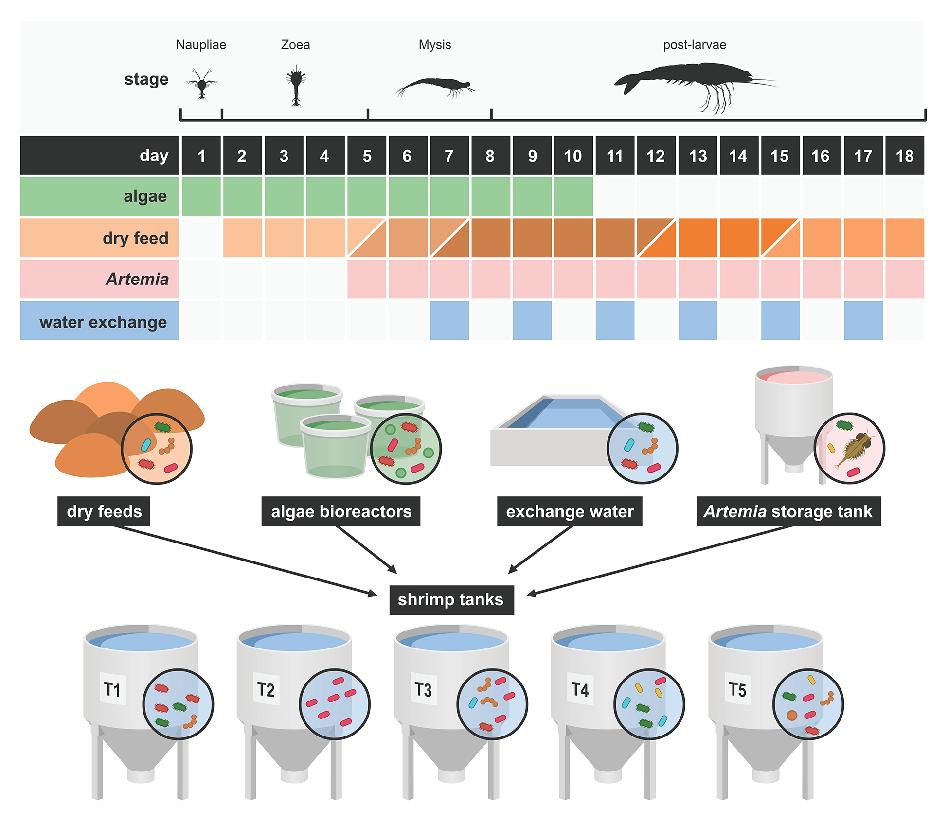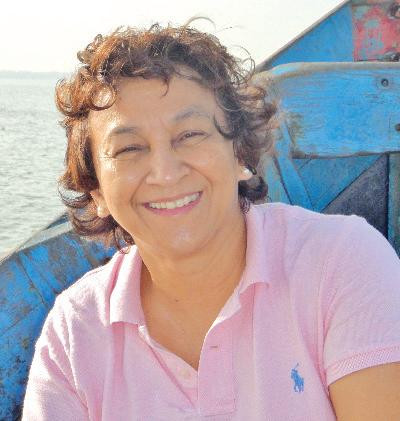
9 minute read
Data sharing for disease management in shrimp farming: More to gain
Sharing data on disease outbreaks could add real value to the industry if all segments of the supply chain work together and if regulators use systems that provide real-time data to support swift action.
By Pau Badia Grimalt and Anton Immink
Diseases and poor health management in shrimp farming are still key obstacles to sustainable growth of the shrimp industry and have a huge economic impact. Shinn et al. (2018) estimated economic losses in Thailand due to episodes of acute hepatopancreatic necrosis disease (AHPND) throughout 2009 to 2016 at around USD7.38 billion. Data collection is not performed regularly by farmers or regulators and disease reporting is not obligatory in many countries. Diseases differ in how they infect and spread but early knowledge of the risks through data sharing amongst producers and regulators can help in ensuring early prevention measures and in reducing the impacts. Relevant data sharing for health management purposes has helped to reduce the negative impact of disease in salmon farming, for example with sea lice, and in livestock commodities such as the swine or cattle industry, for example with foot and mouth disease (FMD).
The global shrimp industry has been impacted by a succession of diseases such as white spot syndrome virus (WSSV), Taura syndrome virus (TSV), AHPND and more recently by the microsporidian parasite Enterocytozoon hepatopenaei (EHP). In Thailand, shrimp is the most important aquaculture species in terms of volume and revenue. In 2010, shrimp production in Thailand fell from 600,000 tonnes to 189,000 tonnes due to disease outbreaks. In 2020, the production was 275,000 tonnes.
Recording disease
Most shrimp farmers do not collect data in a systematic and digital way and therefore it is difficult to move towards an evidence-based approach to improve their businesses. In addition, in Thailand there is no mandatory reporting or record keeping of farmed shrimp disease outbreaks by farmers, although the Department of Fisheries reports to the OIE- World Organisation for Animal Health, notifiable diseases such as WSSV or AHPND.
Nevertheless, numerous technology companies currently offer aquaculture farmers and other industry stakeholders a range of mobile applications, sensors, and other internet of things (IoT) devices to monitor farm performance and to conduct data analysis. Uptake of these technologies in the shrimp industry appears to be slow. Engaging shrimp farmers to use these technologies appears to be more challenging than in other commodity sectors such as salmon, poultry or swine.
Disease control in shrimp farming (like most farming sectors) is complex, as the routes and mechanisms of infection are multifarious. Environment, culture conditions and management practices, all play a role in disease control. To understand disease outbreaks, it is important to be aware of the dynamics within the culture systems, such as the potential source of each infection, their routes of infection, how they might spread or propagate, the conditions required or associated with infection events, and the relative susceptibility or resilience of groups within the population (age, developmental state, strain, etc.). The subsequent development of control strategies can then be based on this baseline information. Shrimp culture systems are not standardised, further adding to the complexities of developing management and control strategies. If the routes of infection can be identified and control measures implemented quickly, then it is possible to reduce the probability of a disease event occurring or, depending on the mechanism involved and pathogenicity, reduce the severity of the event.
Understanding disease management through data sharing with the MyShrimp app in Thailand.
Coping with disease
Farmers and the industry have adopted different strategies to cope with pathogens and reduce disease outbreaks. Biosecurity measures and prevention such as key control points at the hatchery are still among the most effective ways to minimise the probability of infection or reduce the spread and magnitude of an infection. Crab fences are common in shrimp farms and are one of the main effective barriers to avoid WSSV infections. Crabs are carriers and act as entry points of this virus into the ponds.
Training on farm biosecurity measures and disease data sharing.

Once a pond is infected, in most situations, there is little a farmer can do to eradicate the infection, but through quick interventions, it may be possible to manage the infection during the remaining culture period. In many cases of a WSSV outbreak within a pond, there is no other option open to farmers but to harvest early, if there are interested buyers, or to cull the pond if some of the shrimp are still below market size. This, however, has economic implications as larger shrimp are both more valuable and subject to less price variation than smaller ones. If the shrimp are too small to be sold, farmers typically destroy the whole stock and disinfect the pond. Some farmers may choose to live with the disease where subsequent crops may have lower production such as the case of EHP infections.
Data sharing
Data sharing can help in different ways, but each disease or health management issue needs to be identified and understood to know where, how and when it needs to be solved. The kind of data, when and where to be shared, to and from whom, and why sharing it are some of the key questions and approaches that need to be considered when sharing disease monitoring data. Increased and early knowledge of a disease outbreak provides time to react and introduce or expand biosecurity measures. It can also mean lower intervention costs as opposed to addressing more advanced infections or even worse, when there are no options left other than harvest or destroy.
A good recent example of health management and data sharing is the sharing of COVID-19 information across countries and regions, including daily reports on the number of new infections, deaths, control measures and recoveries. Identification and understanding of the disease spread routes is very important to control and reduce risks of disease outbreaks. Therefore, sharing data is beneficial to farmers if those routes are controlled. Both in terrestrial and aquatic systems, the mechanisms and routes of transmission of diseases are similar. They are associated with the movement of live animals, water or inert objects where the disease can live, and these constitute the main routes that need to be controlled.
Even though there is no structured or digitalised data sharing on shrimp farming and disease outbreaks, regular informal data sharing is happening among farmers. Personal or group communications in online chat groups and in farmers’ organisations such as clubs and cooperatives play an important role in information dissemination. Seminars, monthly meetings and sharing experiences are common practices among farmers within a cluster, where they learn from each other through the sharing of past experiences and from new knowledge. Examples of farming practices, news on regulation updates, new technology, updates on requirements from processing plants, difficulties in each step of the supply chain, etc. are shared yearly in shrimp fairs or seminars.
There are of course, negative outcomes to reporting on diseases or losses. Shrimp farming has been hit before by international news focussing on the environmental issues of shrimp farming and decontextualising some of the information related to disease. Processing plants and shrimp buyers may take advantage when they know that a pond needs to be harvested due to diseases by offering prices lower than the market price. A farmer who is known to have disease on their farm may face inconvenience or alienation. But shrimp farming is not alone; similar issues also happen in the farming of other commodities such as swine and cattle.


Sharing the common challenges faced in a farm due to diseases and farm assessment.

Alerts are needed
Shrimp health management programmes need to be upgraded in their objectives, scope and approach to reduce the impact of diseases. Recent alerts from international experts about the diseases DIV1 (decapod iridescent virus 1) and HPTV (hepatopancreatic translucence virus) reported from hatcheries present an immediate and urgent concern to the industry, on top of the already numerous existing diseases. Globally, hatchery sources present significant concerns because diseased post larvae movement results in the vertical transmission and spreading of diseases to grow-out ponds. Farmers need to be reminded to source from reputable hatcheries, perform effective sanitation of ponds and test post larvae before stocking to ensure that their farms remain disease-free.
It is strongly recommended that regulators for aquatic animal health follow recommendations such as strengthening hatchery biosecurity, with a focus on the control and monitoring of imported broodstock and post larvae as advised by the OIE. They should support more informed policy development and more responsive disease management strategies by increasing post larvae and grow-out testing and publishing real-time disease outbreak and control data. All tiers of the supply chain have data that help in disease management. There are tools available for reporting this data in real-time that could help to control diseases. All farmers should be socially responsible to share data for the good of the industry and working towards more sustainable practices.

Balancing the benefits
It is challenging for individuals to adopt approaches that may ‘point the finger’ in the short term. However, if the majority of farmers were to use data more effectively and if regulators required it and acted on it in real time, there is a tangible opportunity to overcome the on-going and repeated disease cycles that adversely impact the Asian shrimp industry. Acting fast and sharing data will help prevent a repeat of the chronic economic impacts associated with established diseases such as AHPND, WSSV and EHP amongst others – and ultimately lead to a more resilient and robust shrimp industry.
Real-time data about disease issues and farm management could also benefit the whole industry through increased transparency and greater market value of products. Who knows, in the near future it may turn out to be an alternative to certification. We leave you here to ponder: should the industry miss this opportunity to improve governance and aim for a more sustainable industry with less risks from disease outbreaks?
Pau Badia Grimalt is a biologist from Barcelona with an international master’s degree in Thailand in aquaculture and fisheries. Since 2018, he is pursuing a PhD degree in aquaculture from the University of Stirling (UK). Pau is also the manager of ThaiTIP, a multi-stakeholder innovation platform between European and Thai aquaculture stakeholders.
Anton Immink is the CEO of ThinkAqua – a new NGO promoting innovation in aquaculture to help the industry move to greater sustainability. He was formerly Global Aquaculture Director at Sustainable Fisheries Partnership. Email: anton.immink@thinkaqua.org
Pau and Anton are colleagues on the IDH and Walmart Foundation supported SHRImp project (Shrimp Health Resources Improvement project) that aims to improve health management in shrimp farming in Thailand through data sharing. The work referenced here is part of that project and has involved a wide team of partners all contributing to greater and improved learning.










